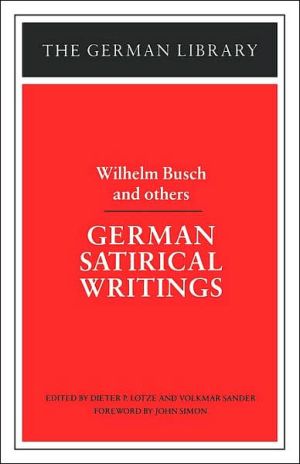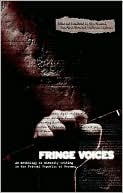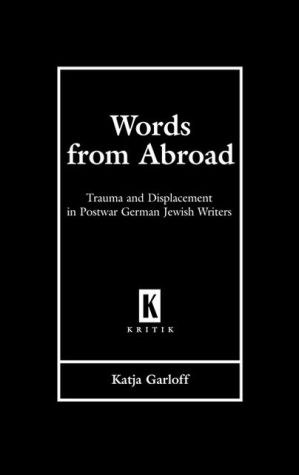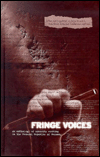The Construction of Textual Authority in German Literature of the Medieval and Early Modern Periods
Current interest in the intersections of various kinds of discourse provides the basis for a fresh look at diverse textual strategies of cultural legitimation. This collection presents an introductory essay and eleven studies (written in English and German) that address claims to authority associated with differing kinds of texts from such varied perspectives as political performance, popular culture, history of science, interrelations between verbal texts and other arts, and artistic...
Search in google:
Current interest in the intersections of various kinds of discourse provides the basis for a fresh look at diverse textual strategies of cultural legitimation. This collection presents an introductory essay and eleven studies (written in English and German) that address claims to authority associated with differing kinds of texts from such varied perspectives as political performance, popular culture, history of science, interrelations between verbal texts and other arts, and artistic professionalism. Read together, these studies illuminate historical contingencies and reveal important changes in the "technologies of authority" from the twelfth through the eighteenth centuries. The contributors are Claire Baldwin, Thomas Cramer, Arthur Groos, Walter Haug, C. Stephen Jaeger, Jane O. Newman, James F. Poag, David Price, Rudiger Schnell, Lynne Tatlock, Horst Wenzel, and Gerhild Scholz Williams.
The Construction of Textual Authority in German Literature of the Medieval and Early Modern Periods\ \ The University of North Carolina Press\ Copyright © 2001 University of North Carolina Press\ All right reserved.\ ISBN: 978-0-8078-8123-1 \ \ \ \ Introduction\ James F. Poag and Claire Baldwin \ Pro captu lectoris habent sua fati libelli. -Terentianus Marcus, De litteris Syllabis\ When the textual authority of his inscription on the cross was questioned, Pontius Pilate famously issued the simple rebuttal, "What I have written, I have written," and relied on his political privilege to end the debate. For Galilei, however, such an answer would not have sufficed to silence his critics. The essays collected in this volume, previously presented at the Fourteenth Biennial St. Louis Symposium on German Literature (March 1998), all direct attention to the multifaceted relationships between author, text, and audience and to the manifold fashions in which authority is asserted or challenged in medieval and early modern German texts. We thought it would be productive to view these works together. During the periods in question, the authority represented by canonized texts like the writings of the ancients or those of the church fathers was, of course, paramount and the weight of textual precedent and textual proof enormous. One site where this can be seen is in the traditions of commentary. Commentaries recognize the text they interpret as authoritative and lend those texts a further and renewed legitimacy through their own act of interpretation. But it is clear that specific techniques of shoring up authority not only reveal aspects of the dominant evaluative systems of the day; they also bring into focus the intellectual matrices that allow for historical and textual transformations, for challenge to authority. Our volume, when taken as a whole, reveals-among other things-precisely this complex interplay between negation and affirmation.\ I\ The authority of a text may be claimed by its author, but it is granted or refused by an interpretive community and is therefore subject to negotiations between author and reader, which leave their mark on the texts themselves. The current interest in the intersections and competitions between various kinds of discourse provide the basis for a fresh look at claims to authority and diverse textual strategies of cultural legitimation. The generic and discursive expectations and possibilities exploited or created in differing kinds of texts are addressed in the essays that follow from such varied perspectives as political performance (Groos), popular culture and daemonologies (Scholz Williams), history of science (Newman), interrelations between verbal texts and other arts (Cramer, Price, Tatlock, Baldwin), and artistic professionalism (Tatlock). Our topic, The Construction of Textual Authority, offers a point of convergence for a wide range of approaches to medieval and early modern studies. Together, the essays span a period of seven centuries, yet this diachronic breadth does not preclude continuities between medieval and early modern cultures or the similarities of critical interest found in the contributions to this volume. Read together, they illuminate both specific historical contingencies of various moments across this spectrum from the twelfth to the eighteenth centuries and the changes in "technologies of authority" (Tatlock) that these cultures manifest.\ One way in which texts construct their authority is through reference to the personal standing of the speaker or author. Personal authority can derive from various sources: from divine or secular artistic inspiration; from status as a representative of an institution or higher authority; from prestige as a renowned author; from recognized skills, knowledge, or experience; or from an exemplary vita. The junctions of oral communication, dependent on the physical presence of an author or authorized speaker, and written communication in the medieval period give rise to new textual tactics to transfer the authority embodied in a speaker to the written text, as a new embodiment of authority. The representative appearance of a speaker-for example, a messenger (Wenzel) or a preacher (Schnell)-of a text mediated orally can vouch for its credibility, and the bodily presence of this mediator embeds the communication in a particular social, physical context replete with nonverbal signs to be interpreted, for which the written text needs to compensate in establishing its own textual authority. However, the relationship between the personal profile of an author and the authority of the text is not always straightforward. An emphasis on personal authority can lead to questions regarding textual authenticity. Anonymous publication shifts the legitimizing strategies of the texts away from the person of the author. The text can claim authority not invested in an individual person by emphasizing its materiality and written form (Schnell), or its significance can lie in its very divergence from lived experience (Jaeger). As the concept of authorship undergoes historical transformations, assertions of personal artistic authority are configured textually in varying fashions. Medieval artists express their aesthetic sovereignty in play with surface variation on philosophically authoritative thematic substance (Cramer) or celebrate new fictional means of approaching veiled truths, thereby calling attention to their personal creativity, guided by divine inspiration (Haug). The seventeenth and eighteenth centuries witness different arguments for the social value of artistic expertise that support authorial prestige. The nascent culture of professionalism is apparent in the artistic profiles of musicians found in baroque novels (Tatlock), whereas Enlightenment values of critical, empirical observation, refined aesthetic sensibilities, and individual genius provide a foundation for declarations of personal authority in the eighteenth century (Baldwin).\ A second overarching means of investing texts with authority is through reference to other respected texts. Constructions of authority through intertextuality can draw on a wide array of resources, from classical learning and sacred Scripture to legends and recognized fictional source texts and topoi, from paradigms of socially influential discursive fields (juridical, medical, theological) to evocations of other art forms. The relationships established between the new text and its intertexts can likewise be configured in diverse manners. Intertexts can be used to support or substantiate claims of content or authoritative gestures (Scholz Williams). Texts can align themselves with authoritative positions through intertextuality-or define themselves in contrast to spurious or inferior ones-to assert legitimacy, ideological rectitude, and power. New texts can borrow their authority by fashioning themselves as part of an authoritative tradition, as imitation or derivation; they can concurrently assert their own originality through juxtaposition and comparison to the older texts, underscoring their own strategies of adaptation or variation (Cramer, Groos, Baldwin). A philological relationship to the intertexts, such as exegesis, commentary, or translation, shores up the personal authority of an author by displaying divine favor and/or learnedness and expertise, while drawing attention to the contingency of the work being interpreted, and thus to its controversial potential (Price). Philological or learned engagement with traditionally authoritative texts can simultaneously subject them to new scrutiny and debate and reestablish their credibility through historically new cultural paradigms of validation. This process then reshapes discursive fields, for example, by reframing sacred philology as a science, not a miracle, and introducing it as a mechanism of reform (Price) or verifying the authority of classical texts through the modern test of empiricism (Newman). Intertextual strategies of constructing authority frequently direct the reader to the particular textual conditions of the works thus interpolated, as well as, self-reflexively, to the materiality of the new text and to its processes of production as they influence the creation of an authoritative textual profile, including such factors as the choice of linguistic medium, genre, or institutional status.\ Textual authority constitutes itself, ultimately, in reception. A third general strategy important for establishing textual legitimacy is therefore the direct appeal to the authority of the audience, its social institutions, and common cultural practices. Reference to social and cultural authority can serve disparate and even contradictory purposes. Practical motivations for textual devices such as dedications aimed at assuring the approval of a particular audience might include currying favor with those in political power or avoiding censorship. Recourse to authoritative discourses may be used to applaud reigning mentalities or to question or challenge them; a text can elicit audience approbation through confirmation of what is familiar, through appropriation of accepted arguments to support new contentions, or through revelation of disjunctions within a culture. The illumination of constructions of textual authority can thus uncover, for example, the textual mechanisms of wielding political, juridical power, as in the invocation of authorities to persecute a particularly defined, gendered social group in sixteenth-century witch tracts (Scholz Williams), or the negotiation of conflicts in religious and political identities and values, as in the entry of Charles V into Nuremberg (Groos). Texts may actively fashion and cultivate the image of an ideal audience and mode of desired reception as one means of self-definition and cultural legitimation. The varied strategies of constructing textual authority with requisite reference to the social contexts of an interpretive community clearly mark, exploit, and help shape particular cultural constellations and transitions in specific historical moments.\ This volume attempts to offer a stimulating diversity of critical approaches to the common issue of the construction of textual authority in German literature of the medieval and early modern periods while simultaneously creating new occasions for scholarly dialogue on shared interests across the broad time span addressed in the essays of its contributors.\ II\ One of the fundamental questions in any inquiry into the authority of texts must be that of the role of traditional forms. This is particularly important for medieval literature. Thomas Cramer (Chapter 2) compares poetry, music, and painting from the medieval and modern periods. He argues that medieval tradition sought to portray the world as essentially unchanging. In the medieval period, artistic originality, the aesthetic dimension of a work, lay in "surface" variation, in the reconfiguration of "accidents" lodged in an unchanging "substance" or pattern. The latter, a repeated, underlying pattern (Muster), conveyed authoritative sociopolitical and religious behavioral models. For medieval artists, the aesthetic and ideological dimensions of a work could be viewed as separable. For moderns, on the other hand, variation came to be seen as inseparable from meaning. Historically, this represents a change from "ornamental" to "substantial" variation.\ Walter Haug (Chapter 3) approaches the problem of medieval artistic representation from a different point of view, examining the interaction between innovation and tradition. He contends that the medievals did not perceive the world as a totally transparent environment, as one whose interpretation was fixed; its meaning had, in fact, been partly veiled by sin. Divine aid was required to reillumine its darkness. Haug seeks to describe what happens to this schema when, as part of a complex historical development, the ultimate sense of things becomes even more radically obscured. A new kind of literary art emerges, an art that seeks through its own (fictional) means to become the bearer of truth. The poet now invokes God to aid his naturally given creativity. Authority is lodged increasingly in the human subject. Despite the conservative nature of medieval culture, tensions within it nourish and bring forth more modern forms of poetic legitimation.\ New forces are also generated through the growth of literacy in medieval culture; different kinds of discourse compete with one another for authority. Horst Wenzel (Chapter 4) examines the complex relationship between orality and written text in the literature of the Blütezeit. Particularly revealing is the case of the Nibelungenklage. The bishop of Passau commissions the work; the fictional messenger, Swä, "reports" it; Konrad "writes" it down. The work's production is depicted as a cooperative effort between the oral culture of the laity and the written culture of the clerics; the witness of one who has actually seen and heard remains a legitimating factor in the transition from bodily to textual memory. In the course of the development from Mündlichkeit to Schriftlichkeit, however, the work increasingly gains its authority from an intertextual location. The speaker-narrator continues to make orality present but functions-in the written medium-through increased reference of his text to other texts.\ C. Stephen Jaeger (Chapter 5) offers yet another point of view in his discussion of the emergence of the written text during the High Middle Ages. Jaeger finds in this era a new awareness, an emerging recognition of the antagonistic relationship "between deeds and their records." In this environment the written text itself may become a symbol of decline; it may be perceived as a distancing medium, which cuts one off from the compelling authority of the originary event. He argues that the emergence of literacy was accompanied by a sense of loss. He points out that contemporary observers saw their era less as an age of accomplishment and more as a time of crisis: in poetry, in intellectual discipline, in law, in religion, and in ethics.\ Like Wenzel, Rüdiger Schnell (Chapter 6) investigates the complicated interrelationship in medieval culture between oral and written communication. He uses the medieval sermon as the basis for his discussion. A sermon delivered before a congregation will, for example, derive its authority preeminently from the virtuous life of the preacher who speaks; on the other hand, in a culture that is growing increasingly literate, the very fact that a sermon is written down can make it seem more believable. Collections of anonymous sermons may aspire to a high degree of authority, if they are didactically effective; on the other hand, the authority of collections can be guaranteed by attaching them explicitly to famous names. During the period considered there is considerable variety in authorizing strategies, which is explained by the simultaneity of Mündlichkeit and Schriftlichkeit. Despite this variety, however, a form of authority linked to "author" and "authorship" increasingly emerges in the course of the later Middle Ages.\ Cultural artifacts may express the tension between competing sociopolitical institutions. In the early sixteenth century the relations between German city and empire were particularly contested. Arthur Groos (Chapter 7) examines the symbolic significance of the "Ehrenpforte" erected by free citizens of Nuremberg to honor the emperor on the occasion of his ceremonial visit to that city in 1541. Drawing upon architectural handbooks and texts of Hans Sachs, Groos examines the interplay between the iconography of the arch and the Latin epigrams inscribed on its sides. He discovers not the univocal expression of imperial authority but a "dialectic of obedience and hesitation, hierarchy and community, of mutually linked and separated imperial and civic spheres of influence." The arch's "discourse of homage is balanced by one of difference."\ In the early sixteenth century new movements and disciplines made new assertions. In his examination of the relationship between artistic and textual traditions, David Price (Chapter 8) uncovers some of the fundamental concerns of the era. He sees clear connections between Dürer's art and the claims to truth advanced in the scriptural scholarship of the humanists. Throughout his career, the artist concerned himself with the problem of representing, iconographically, essential interests of biblical philology. Dürer's depiction of Saint Jerome is, for example, rooted in the scholarship of Erasmus and his portraiture reflects the influence of humanistic discipline. A major part of Dürer's reception of the Reformation is a reflection of Erasmian learning with "its special interest in the authority and condition of the Bible."\ (Continues...)\ \ \ \ \ Excerpted from The Construction of Textual Authority in German Literature of the Medieval and Early Modern Periods Copyright © 2001 by University of North Carolina Press. Excerpted by permission.\ All rights reserved. No part of this excerpt may be reproduced or reprinted without permission in writing from the publisher.\ Excerpts are provided by Dial-A-Book Inc. solely for the personal use of visitors to this web site. \ \
Foreword / Abraham F. LowenthalAcknowledgments 1 Introduction / David Pion-Berlin 2 Reason, Culture, or Structure?: Assessing Civil-Military Dynamics in Brazil / Wendy Hunter 3 Military Attitudes toward Democracy in Latin America: How Do We Know If Anything Has Changed? / J. Samuel Fitch 4 Latin America: Objective and Subjective Control Revisited / Ernesto L¢pez 5 The Organizational Dynamics of Militaries and Military Movements: Paths to Power in Venezuela / Deborah L. Norden 6 Civil-Military Circumvention: How Argentine State Institutions Compensate for a Weakened Chain of Command / David Pion-Berlin 7 Crafting Civilian Control in Argentina and Venezuela / Harold A. Trinkunas 8 Institutions, Transitions, and Bargaining: Civilians and the Military in Shaping Postauthoritarian Regimes / Felipe Agero 9 Latin American Economic Integration and Democratic Control of the Military: Is There a Symbiotic Relationship? / David R. Mares 10 Historical Foundations of Civil-Military Relations in Spanish America / Brian Loveman Bibliography Contributors Index





